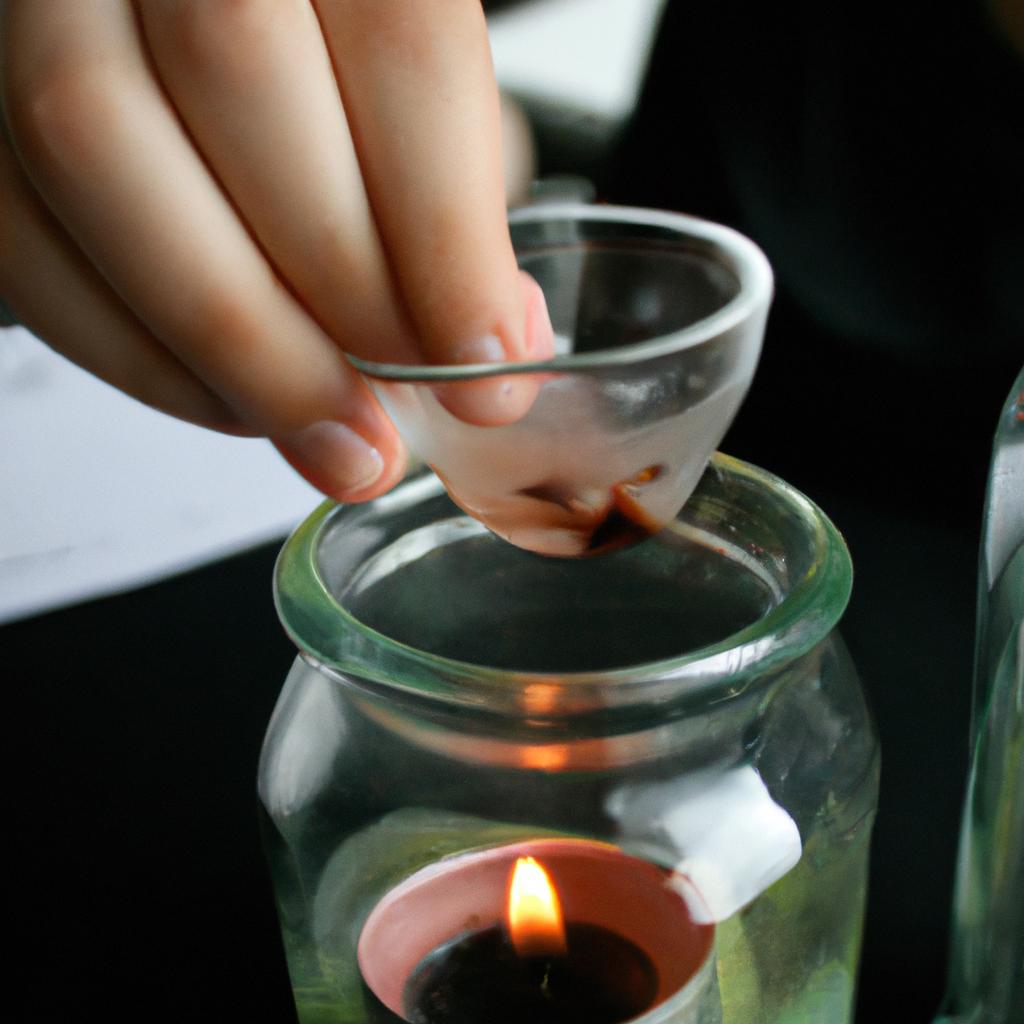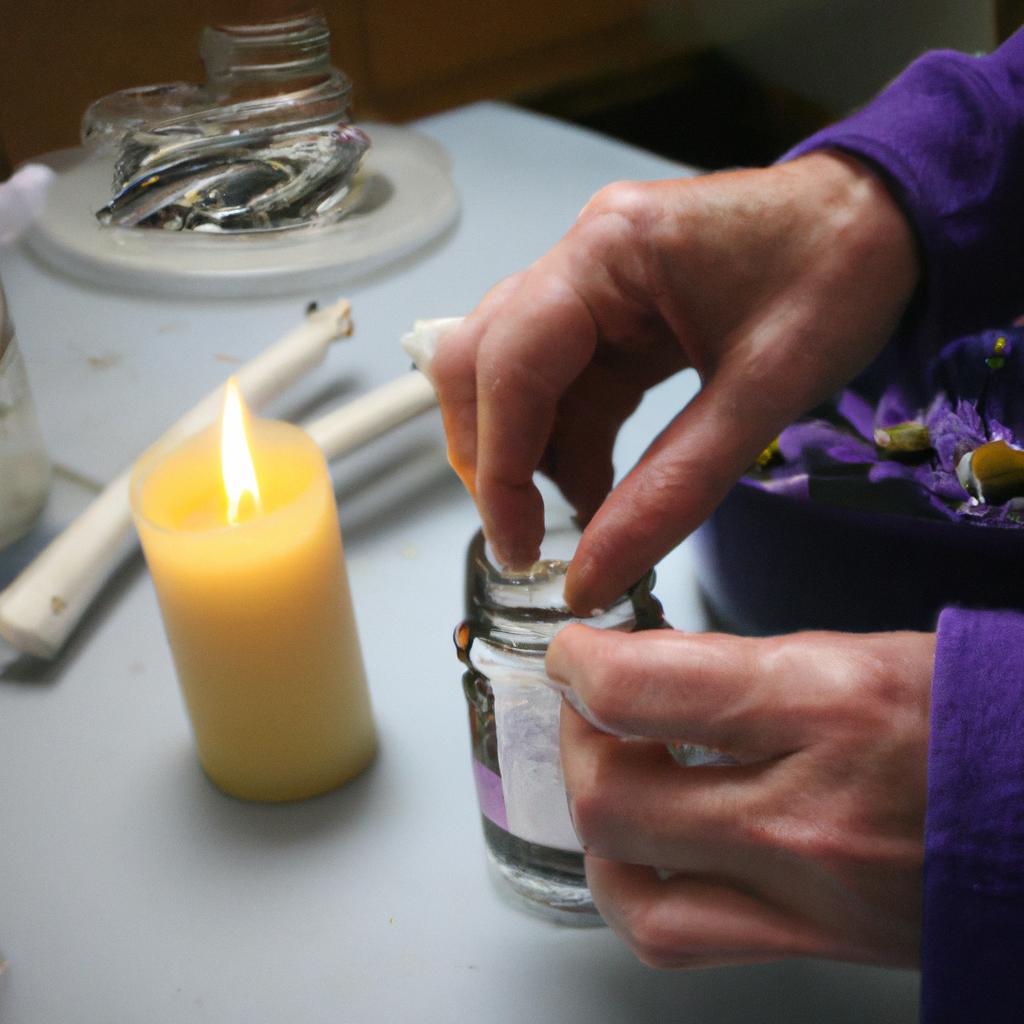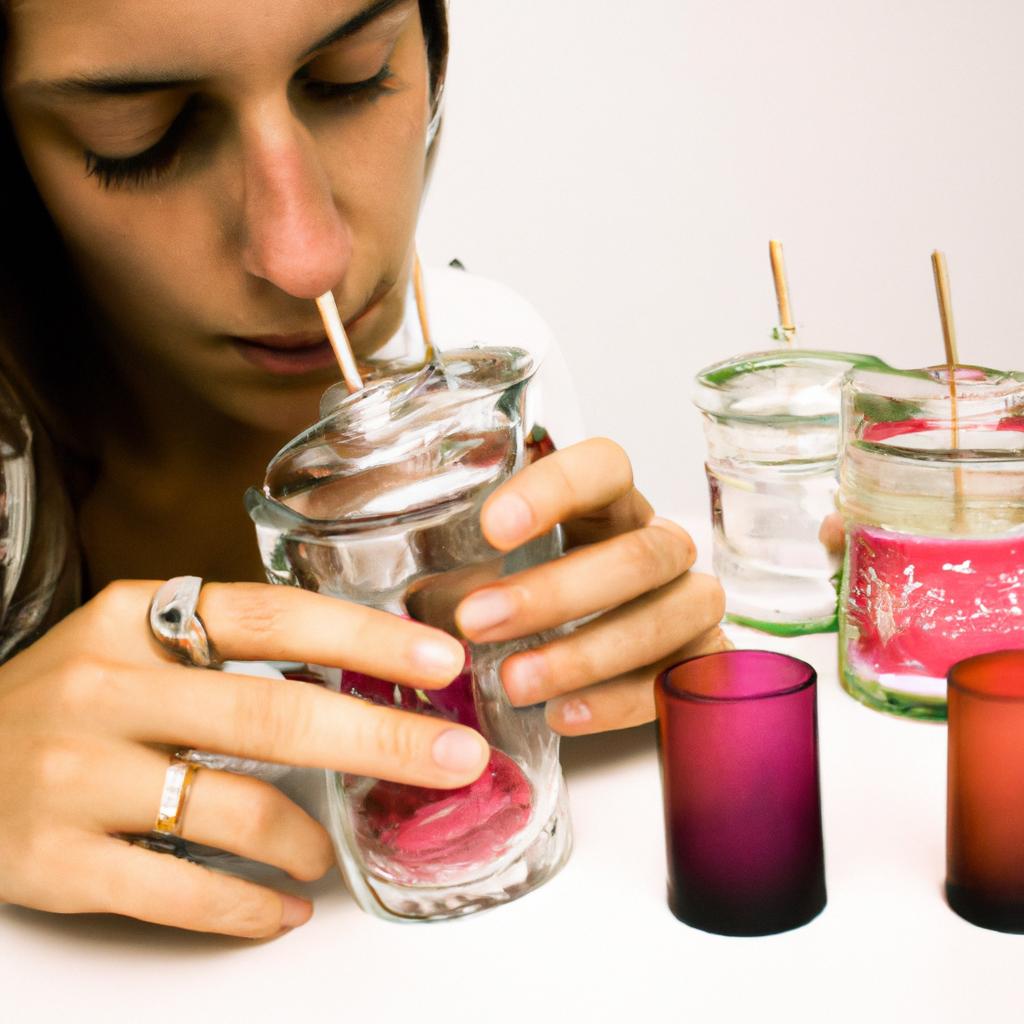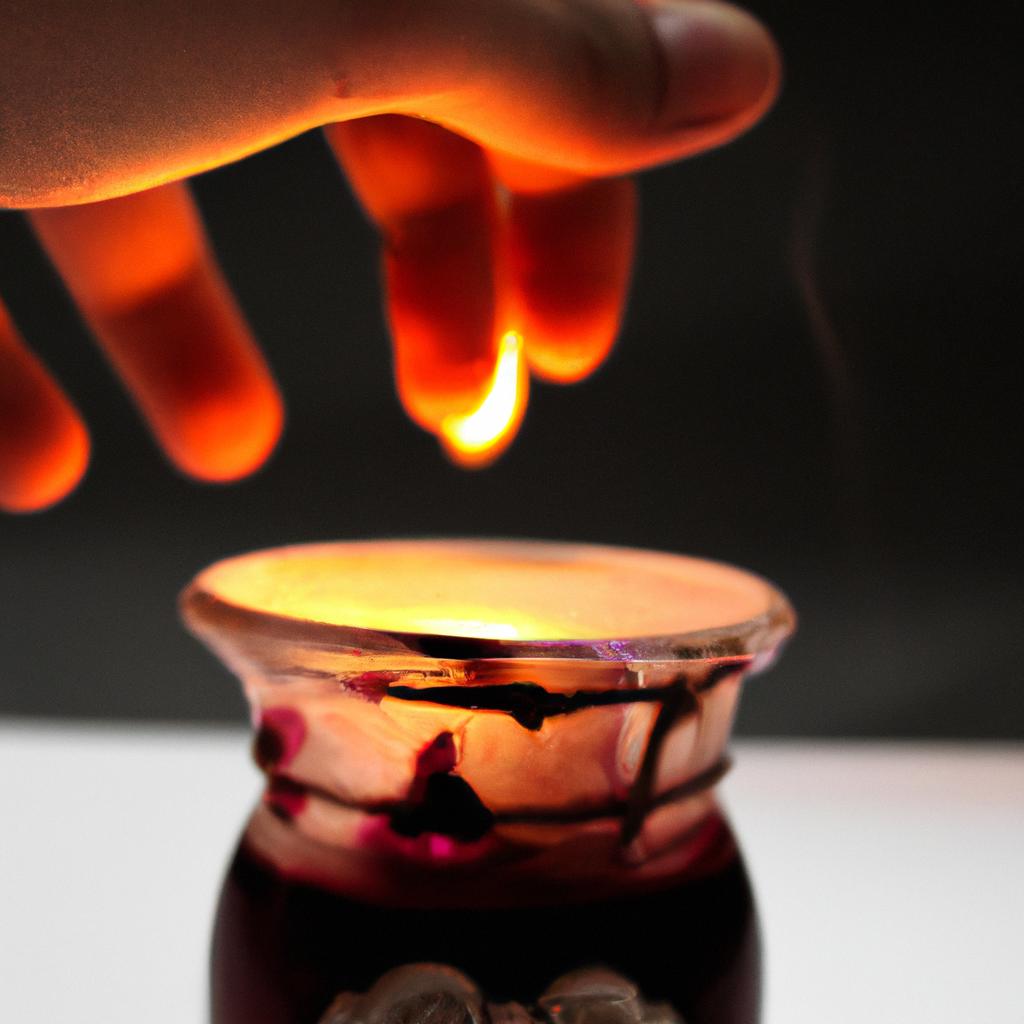Blended Candle Fragrances: The Art of Candle Making and Candle Fragrance

The art of candle making has a rich history that dates back centuries, with candles being used not only for practical purposes such as providing light but also for their aesthetic and aromatic qualities. In recent years, there has been a surge in the popularity of blended candle fragrances, where multiple scents are combined to create unique olfactory experiences. This article explores the fascinating world of blended candle fragrances, delving into the process of candle making and highlighting the importance of selecting complementary scent combinations.
Consider this scenario: Imagine walking into a cozy living room adorned with flickering candles, each emitting its own distinct fragrance. As you breathe in the air, you are greeted by a delightful blend of lavender and vanilla intertwined with hints of citrus. Such an experience exemplifies the artistry behind blending candle fragrances – creating harmonious compositions that enhance ambiance and evoke emotions. Blended candle fragrances offer endless possibilities for customization, allowing individuals to craft their own signature scent or experiment with various combinations to suit different moods and occasions.
The History of Candle Making
Imagine a dimly lit room, with the soft flickering light of candles casting dancing shadows on the walls. Candles have been an integral part of human history for centuries, providing both practical and aesthetic purposes. From illuminating homes to symbolizing religious rituals, their significance cannot be understated. This section delves into the fascinating history of candle making, tracing its origins back to ancient civilizations.
In ancient times, candles were primarily made from various materials such as tallow (animal fat), beeswax, and plant oils. For instance, in Egypt around 3000 BC, animal fats were molded onto reeds or papyrus stalks to create torches that could burn for several hours. Similarly, the Romans developed dipped candles using tallow or beeswax-coated wicks twisted together.
Over time, advancements in technology led to innovations in candle making techniques. The Middle Ages witnessed the emergence of chandlers – skilled craftsmen who specialized in creating candles. These artisans refined the process by dipping wicks repeatedly into molten wax until they achieved the desired thickness. By utilizing molds and experimenting with different materials like spermaceti (a substance found in the heads of sperm whales) and stearin (a derivative of palm oil), they further improved candle quality.
As society progressed through the Industrial Revolution and beyond, new methods transformed candle production once again. In the late 18th century, French chemist Michel Eugène Chevreul discovered how to extract stearic acid from animal fats more efficiently. This development resulted in cleaner-burning candles with reduced smoke and odor.
Reflecting upon this historical journey allows us to appreciate not only the functional aspects but also the emotional connection we share with candles. They evoke a sense of tranquility and nostalgia that transcends time and cultures:
- The warm glow of candlelight creates an intimate ambiance during romantic dinners.
- Scented candles infuse our living spaces with fragrances that evoke memories and emotions.
- Candles symbolize hope, spirituality, and remembrance in various religious ceremonies.
- Candlelight vigils serve as powerful demonstrations of unity and solidarity during times of crisis.
By exploring the history of candle making, we gain a deeper understanding of how these simple objects have shaped human experiences throughout civilization. In the subsequent section on “Understanding Essential Oils,” we will delve into another crucial aspect of creating blended candle fragrances: harnessing the power of nature’s aromatic essences.
Understanding Essential Oils
Blended Candle Fragrances: The Art of Candle Making and Candle Fragrance
The History of Candle Making has laid the foundation for the craft, but understanding essential oils is crucial to creating unique and captivating scents. By combining different fragrances, candle makers can achieve a wide range of aromatic experiences that appeal to various preferences. Let’s explore how blended candle fragrances enhance the art of candle making.
Imagine a tranquil evening at home, with soft ambient lighting emanating from a beautifully crafted candle on your coffee table. As you inhale its gentle fragrance, notes of lavender mingle with hints of vanilla and sandalwood, instantly transporting you to a serene oasis. Blending these three scents together creates an exquisite harmony that elevates the overall sensory experience.
To create sensational blended candle fragrances, consider the following:
- Balance: Combining complementary scents in careful proportions ensures a harmonious blend where no single note overpowers others.
- Complexity: Layering multiple fragrances adds depth and complexity to the scent profile, enhancing its allure.
- Uniqueness: Experimentation with unconventional combinations sets candles apart by offering something new and intriguing.
- Theme or Mood: Tailoring blends to evoke specific emotions or atmospheres captivates customers seeking personalized experiences.
By skillfully blending essential oils, candle makers unleash their creativity and ingenuity. To better understand this process, let’s take a closer look at an example showcasing popular blended candle fragrances:
| Fragrance Combination | Description |
|---|---|
| Citrus + Herbs | A vibrant mix that invigorates spaces with refreshing zest and earthy undertones |
| Floral + Woods | An elegant fusion exuding sophistication while embracing nature’s beauty |
| Fruits + Vanilla | A sweet symphony reminiscent of delectable desserts and warm comfort |
Through thoughtful experimentation and meticulous craftsmanship, artisans can create endless possibilities using blended candle fragrances. By harnessing the power of essential oils and their unique characteristics, candle makers captivate customers with scents that transport them to cherished memories or evoke desired emotions.
The next section will delve into popular blended candle fragrances, exploring specific combinations that have gained popularity among enthusiasts worldwide. Discover how these captivating aromas can elevate any space and envelop it in a symphony of delightful scents.
Popular Blended Candle Fragrances
Blended Candle Fragrances: The Art of Candle Making and Candle Fragrance
Understanding Essential Oils
Now that we have explored the basics of candle making, let us delve into the fascinating world of essential oils. These highly concentrated plant extracts play a crucial role in creating captivating blended candle fragrances. To illustrate their importance, imagine an exquisite scented candle that transports you to a serene, lavender-filled garden on a warm summer evening.
Essential oils offer endless possibilities for crafting unique and delightful aromas. Here are some key points to understand about these aromatic compounds:
- Highly Concentrated: Essential oils are obtained through various extraction methods such as steam distillation or cold pressing, resulting in potent concentrations of fragrance.
- Wide Variety: There is a vast array of essential oils available, each with its distinct aroma profile and therapeutic properties. From calming lavender to invigorating citrus notes, the options are abundant.
- Blending Possibilities: One of the exciting aspects of using essential oils in candle making is the ability to create custom blends. By combining different oils in precise proportions, artisans can craft complex and harmonious fragrances that evoke specific moods or experiences.
- Scent Strength: It’s important to note that certain essential oils have stronger scent profiles than others. Some may require less oil per batch while others may need more to achieve the desired level of fragrance intensity.
To further explore the potential combinations and effects of essential oil blends in candles, consider the following table showcasing popular pairings:
| Essential Oil | Fragrance Profile | Complementary Pairing |
|---|---|---|
| Lavender | Calming and floral | Vanilla |
| Citrus (e.g., orange) | Energizing and uplifting | Bergamot |
| Rosemary | Herbal and invigorating | Peppermint |
| Sandalwood | Woody and warm | Patchouli |
As you can see, blending essential oils allows for the creation of complex fragrances that awaken different emotions. By artfully combining scents in candles, candle makers have the power to transport individuals to various sensory realms.
In the upcoming section on “Choosing the Right Wax for Your Blended Candles,” we will explore another crucial element in candle making – selecting the ideal wax base for your creations.
Choosing the Right Wax for Your Blended Candles
Blended Candle Fragrances: The Art of Candle Making and Candle Fragrance
Popular Blended Candle Fragrances have become a sought-after choice for candle enthusiasts, as they offer unique scents that cannot be achieved with single fragrance oils alone. By combining different fragrances, candle makers can create captivating aromas that appeal to a wide range of preferences. For example, let’s consider the case study of a small artisanal candle company that experimented with blending lavender and vanilla fragrances. This combination resulted in a soothing scent reminiscent of freshly baked goods, which quickly became their best-selling product.
When it comes to choosing the right wax for blended candles, several factors need to be considered. First and foremost is the melting point of the wax. Different waxes have varying melting points, and selecting one that suits your blend is crucial for achieving optimal burn quality and fragrance throw. Additionally, considering the environmental impact is essential; opting for sustainable and eco-friendly waxes aligns well with current consumer trends towards more conscious choices.
To assist you further in creating beautifully scented blended candles, here are some key considerations when experimenting with different fragrances:
- Balance: Aim for harmony between the various fragrance notes used in your blend.
- Complementary Scents: Choose fragrances that complement each other rather than clash.
- Intensity: Experiment with different ratios to find the perfect balance of each scent’s intensity.
- Seasonality: Adjust your blends according to seasonal preferences or upcoming events.
Furthermore, incorporating visual elements into your presentation can enhance emotional engagement. Consider using a table format like this:
| Fragrance Combination | Description | Scent Profile |
|---|---|---|
| Lavender + Vanilla | A calming blend reminiscent of freshly baked goods | Floral + Sweet |
| Citrus + Mint | An invigorating fusion with hints of freshness | Citrusy + Refreshing |
| Sandalwood + Musk | A warm and sensual combination for a cozy ambiance | Woody + Musky |
| Rose + Patchouli | An alluring blend with floral and earthy undertones | Floral + Earthy |
In conclusion, blended candle fragrances offer a world of creative possibilities to explore. By carefully selecting the right wax and experimenting with different fragrance combinations, candle makers can craft captivating scents that appeal to various tastes and preferences. In our next section, we will delve into some valuable tips for effectively mixing candle fragrances, providing you with insights on how to create unique and memorable aromas in your candles.
Tips for Mixing Candle Fragrances
Blended Candle Fragrances: The Art of Candle Making and Candle Fragrance
Choosing the Right Wax for Your Blended Candles
Now, let us explore some valuable tips that will help you create captivating candle fragrances to enhance your overall candle-making experience.
Tips for Mixing Candle Fragrances
To achieve a harmonious blend of scents in your candles, consider the following suggestions:
-
Start with a base fragrance: Begin by choosing one dominant fragrance as the foundation of your blend. This scent should be robust enough to anchor the other fragrances while still allowing them to shine through. For example, if you are creating a tropical-inspired candle, you might choose coconut as your base fragrance.
-
Experiment with complementary notes: Once you have selected your base fragrance, experiment with adding complementary notes to create depth and complexity in your blend. Consider incorporating scents like jasmine or vanilla to complement the coconut base mentioned earlier. These additional elements can add layers of aroma that make your candles more intriguing.
-
Balance intensity carefully: While it is important to create an enticing combination of fragrances, ensure that no single note overpowers the others. Achieving balance is key; otherwise, certain scents may overpower or clash with each other, resulting in an unpleasant olfactory experience for users.
-
Test and refine: As with any creative endeavor, testing and refining are crucial steps in perfecting your blended candle fragrances. Take small samples throughout the process and evaluate how they smell when burned. Adjust proportions accordingly until you find the ideal balance of aromas that evokes just the right mood or atmosphere.
Now that we have explored various techniques for blending candle fragrances effectively, it’s time to delve into vital safety precautions when working with candles – ensuring not only aromatic enjoyment but also peace of mind during their use.
Candle Safety Precautions: Ensuring a Safe Candle Experience
(Transition sentence) Moving on to candle safety precautions, let us now discuss how you can enjoy your candles without compromising safety.
Candle Safety Precautions
Building upon the knowledge of effectively mixing candle fragrances, we now turn our attention to an equally important aspect – ensuring candle safety precautions. By following these guidelines, you can create a safe environment for enjoying your beautifully scented candles.
Candle Safety Precautions:
-
Trim the wick:
- Regularly trim the wick to approximately ¼ inch before lighting.
- This prevents excessive flame height and reduces the risk of soot formation.
-
Use appropriate containers:
- Select heat-resistant glass or ceramic containers that are specifically designed for candle use.
- Avoid using flammable materials such as plastic or wood as they pose a fire hazard.
-
Keep away from combustible items:
- Place candles on stable surfaces, away from curtains, paper products, or any other potential ignition sources.
- Ensure there is ample distance between burning candles and decorative elements like dried flowers or fabric accents.
-
Never leave unattended:
- Always extinguish candles when leaving a room or going to bed.
- Unattended flames increase the risk of accidental fires and should be avoided at all costs.
Case Study Example: Imagine Sarah, an avid candle enthusiast, enjoys winding down each evening with her favorite blend of lavender and chamomile scented candles. One night, she leaves her bedroom briefly without blowing out the candles. Unfortunately, this simple oversight leads to a fire incident that damages her home and poses a threat to her safety. This unfortunate scenario emphasizes why it is crucial to prioritize candle safety precautions at all times.
| Common Hazards | Potential Consequences | Recommended Action |
|---|---|---|
| Leaving candles near flammable objects | Increased risk of fire | Place candles in clear areas away from potential hazards |
| Neglecting proper wick trimming | Excessive flame height and soot formation | Regularly trim wicks to maintain optimal burn conditions |
| Using unsuitable candle containers | Increased risk of fire and container breakage | Choose heat-resistant glass or ceramic containers designed for candles |
| Leaving unattended flames | Increased risk of accidental fires | Always extinguish candles before leaving a room or going to bed |
By incorporating these safety measures into your candle usage routine, you can ensure the enjoyment of beautiful fragrances without compromising on safety. Remember, taking proactive steps minimizes potential hazards and allows you to fully appreciate the ambiance created by your blended candle collection. So go ahead, light up your space with confidence and immerse yourself in the soothing scents that enhance every moment.






